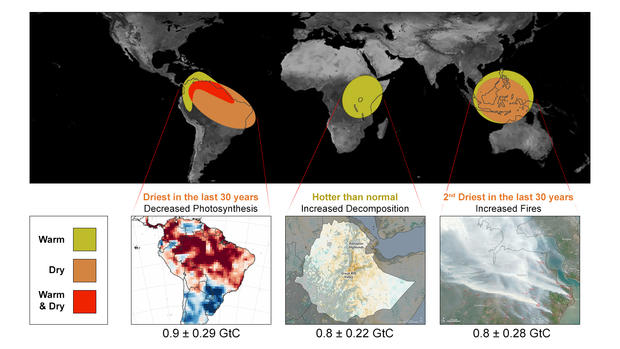What's Behind The Global CO2 Spike? NASA Says Blame El Nino
PASADENA (CBSLA) - Scientists say they now know the cause of the largest annual increases in atmospheric carbon dioxide concentration seen in at least 2,000 years: El Nino.
Researchers at NASA say impacts of El Nino-related heat and drought occurring in tropical regions of South America, Africa and Indonesia were responsible for the record spike in global carbon dioxide.
While scientists had previously suspected the 2015-16 El Nino -- one of the largest on record -- was responsible, it wasn't confirmed until they analyzed data from the first 28 months of data from NASA's Orbiting Carbon Observatory-2 (OCO-2) satellite.
"These three tropical regions released 2.5 gigatons more carbon into the atmosphere than they did in 2011," said Junjie Liu of NASA's Jet Propulsion Laboratory in Pasadena, who was the lead author of the study. "Our analysis shows this extra carbon dioxide explains the difference in atmospheric carbon dioxide growth rates between 2011 and the peak years of 2015-16.
A gigaton is a billion tons.
The study found that record increases in atmospheric carbon dioxide levels were 50 percent larger than the average increase seen in recent years - an increase of about 3 parts per million of carbon dioxide per year, or 6.3 gigatons of carbon.
But in recent years, the average annual increase has been closer to 2 parts per million of carbon dioxide per year -- or 4 gigatons of carbon.
Scientists say the record increases occurred even as emissions from "human activities" in 2015-16 are estimated to have remained roughly the same as they were prior to the cyclical warming pattern of ocean circulation in the central and eastern tropical Pacific Ocean known as El Nino.
Based on OCO-2 data, El Nino increased the total amount of carbon released to the atmosphere from all land areas by 3 gigatons in 2015, 80 percent of which came from natural processes occurring in tropical forests in South America, Africa and Indonesia, according to researchers.
"OCO-2 has given us two revolutionary new ways to understand the effects of drought and heat on tropical forests: directly measuring carbon dioxide over these regions thousands of times a day; and sensing the rate of photosynthesis by detecting fluorescence from chlorophyll in the trees themselves," said Scott Denning, professor of atmospheric science at Colorado State University. "We can use these data to test our understanding of whether the response of tropical forests is likely to make climate change worse or not."
Click here to read the full NASA report.




